For Current Information about the Jozsa Gallery
Go to their Facebook page
The Jozsa Gallery first opened in 2007. This was its website for a number of years. The new owners of the domain wanted to keep the site's content available on the web and to let the inadvertent visitor know that the gallery is still open at Rue Saint-Georges, 24 in Brussels.
Content is from the site's 2008 -2016 archived pages. This archived version of the original site has been restored by the World Art Preservation League and has been sponsored by CleanItSupply.com, national distributor of janitorial supplies and cleaning products. CIS provides funding for many scholarships, educational programs teaching the health benefits of maintaining a clean environment, and other good works unrelated to their primary cleaning products business.
To find the most current information about the Jozsa Gallery go to their facebook page: https://www.facebook.com/Jozsa-Gallery-323582151047682/.
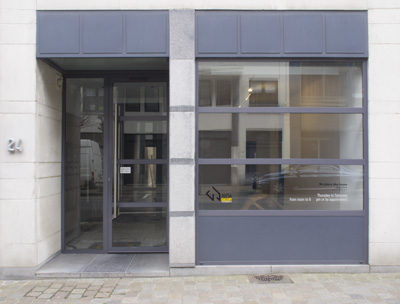
Rue Saint-Georges, 24, Sint-Jorisstraat
B- 1050 Brussels | Belgium
+32 478 48 77 09
Contact : Catherine Jozsa
jozsagallery(at)gmail.com
Open Thursday to Saturday
from noon to 6 pm or by appointment
ARTISTS
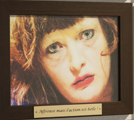
Anna Byskov
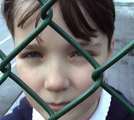
Alexia de Ville de Goyet
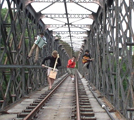
Veaceslav Druta
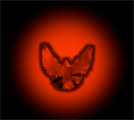
Natalia de Mello
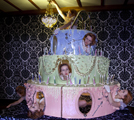
Marie Hendriks
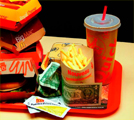
Olga Kisseleva
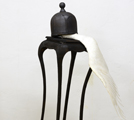
Lucie Lanzini
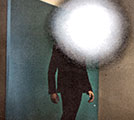
David Leleu
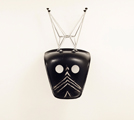
LELLO//ARNELL
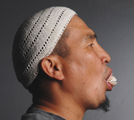
Yerbossyn Meldibekov
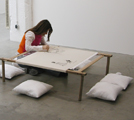
Anila Rubiku
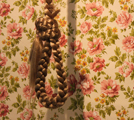
Ruud Van Moorleghem
~~~~~~~~~~~~~~~~~~~~~~~~~~~~~~~~~~~~
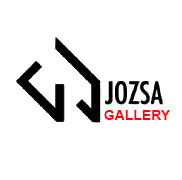
EXHIBITIONS

Chronography Olga Kisseleva September 11 - October 31 2015

Les yeux mi-clos Group Show May 20 - June 27 2015

No place like home Group Show April 2 - May 9 2015

From East to WestDavid Leleu January 15 - February 21 2015

Dread and Relief Lucie Lanzini November 20 2014 - January 10 2015

Fearful Intentions Anila Rubiku September 13 - November 8 2014

Transmutation Group Show May 16 - June 28 2014

L'oeuvre au Noir Group Show April 5 - May 3 2014

On the Steps of Anna Byskov January 16 - March 22 2014

Stockholm Syndrome LELLO//ARNELL November 8 - December 21 2013

The Revolution in the Montains Yerbossyn Meldibekov September 6 - October 26 2013

evasive movements of a pursued animal Lucie Lanzini et Antoine Vanoverschelde May 23 - July 06 2013

Moi aussi je fais des trucs sympas mais n'oublie pas de brancher la prise ! Natalia de Mello March 21 - May 18 2013

espace jeux Laurence Skivée January 17 - March 9 2013
ne me dis pas au revoir Krista Autio November 8 - December 22 2012
Boîte de Vices Olga Kisseleva September 7 - October 27 2012
Post Scriptum Naturalia - Group Show May 9 - June 30 2012

Courage Ruth Gomez March 9 - April 28 2012
The Stratagem of the Invisible David Leleu November 10 - December 17 2011

Epilogue LELLO//ARNELL September 10 - October 29 2011

Naturalia / part 2 Group Show May 19 - July 4 2011
The Origin of the World Wide WebEric Adam March 17 - May 14 2011
Les Ombres sont déjà des Murs Harri de Ville January 14 - March 5 2011
Time remapping Eszter Szabo November 4 - December 18 2010
Laws, Lies, Traditions & Convictions Anila Rubiku September 11 - October 23 2010

Naturalia Group Show May 20 - July 3 2010
Divers Faits Olga Kisseleva March11 22 - May 8 2010
Hide the Curse Alexia de Ville de Goyet January 22 - February 27 2010
Whispered Dances Veaceslav Druta-David Leleu November 28 2009 - January 16 2010
Mutation Yerbossyn Meldibekov September 12–October 24 2009
The Frog Princess Group Show May 29–July 11 2009
Ass-Dialectics Aggtelek March 27–May 16 2009
Drawings Marina Perez Simao January 16–March 14 2009
Break me a Story Alexia de Ville de Goyet-Krista Autio November 14–December 20 200
Shop till you drop Eric Adam September 25–October 25 2008
Fitness Art Centre Olga Kisseleva May 16–July 5 2008

Drawings David Leleu January 18-March 22 2008

Performing the scenography Aggtelek November 9-December 22 2007

Useless creations Tom Schmelzer September 14-October 27 2007

Human FacesFrederic Huyghe / Denis Meyer June 8-July 14 2007

Almost a perfect woman Krista Autio April 27-June 2 2007

There is no spoon Thomas Israël March 9-April 21 2007
The Fake Eric Adam January 19–March 3 2007
~~~~~~~~~~~~~~~~~~~~~~

EXHIBITIONS
Laws, Lies, Traditions & Convictions
Anila Rubiku September 11 - October 23 2010
Other Countries, Other Citizenships
The 54th International Art Exhibition – la Biennale di Venezia - National Participation - ALBANIA
Spazio Rolak, Giudecca 211/b, 30133 Venice
For occasion of the 54 Venice Biennale, Anila Rubiku’s work: "Other countries. Other citizenships" deals with the idea of exile. In it we see a room with sixty hats - a common attribute of immigrants – scattered on the floor and sewn with a white thread. On the wall we see cloth hangers and a sentence which reads: “The person who disowns his own language in order to adopt a different one changes identity and disillusions”.
Dwelling on wanting to belong and being the Other, the installation provokes a love for difference. During the first three days of the Biennale, visitors can acquire a pin with the claim: “Hats protect ideas”, in collaboration with the Fondazione Borsalino, addressing exactly of how emigrants are often employed under their intellectual capabilities.
The Albanian´s migration to (West-) Europe in the 80's, motivated by an aspiration for a new life and citizenship, serves thus as leitmotiv to the entire installation. As in most of Anila Rubiku’s installations, which result of collaborative local community projects or workshops, the sixty male hats have been symbolically sewn by emigrated women.
Focusing more on feelings of being in a country and in culture not of your own and not so much in the pure act of leaving, the installation explores social emotional and biographical frequencies.
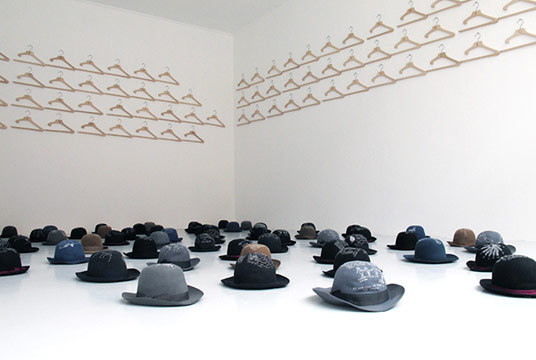
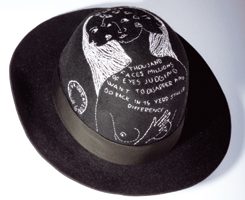
Laws, Lies, traditions & Convictions
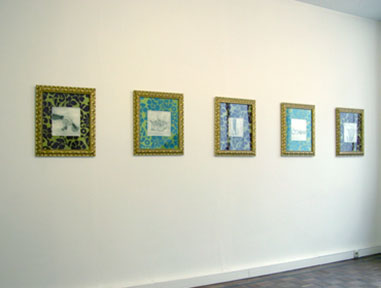
« People who see my work, often find it very feminine mostly, because I use embroidery as the medium. There is nothing wrong with it but, what interests me most in my work is the time spent in making it and what comes with it. » Anila Rubiku
Albanian by birth and a global nomad currently living between Milan and Tirana, Anila Rubiku is an international artist by character and attitudes. The lines quoted from her are about one particular work but the attitude expressed in it is characteristic of her oeuvre as a whole.
Being a nomad means being on the move not only geographically but also mentally and intellectually. It requires a great deal of flexibility and openness of mind but also keeps you in a constant need for self-definition in various environments. Having no place of your own means that you need to re-contextualise yourself every time you occur in a new setting.
For Rubiku, the journey in physical space is thus also a mental trip. Her desire to be somewhere else, the constant reference to the self finds a personal poetic expression in a larger context, where the works are, by definition, relevant on a global scale, exploring questions and problems of urban space and the individual, industrialisation, urbanisation, architecture and the body.
Rubiku’s work are often done in collaborations with others. An immense number of relevant issues, social, societal, ethnic, historical, gender etc. are raised, for example, in the project “The 16 Ways” organised in Tel Aviv she involved a group of very religious Ethiopian women, to stitch sexual scenes on paper.
Two-time participant of the Venice Biennale and presented broadly internationally, Anila Rubiku appears now for the first time in Belgium , making her debute here in a solo show at the Jozsa Gallery. The exhibition showcases six works:
An installation of 24 drawings, In Harmony takes you inside the most organic clusters of human nature, opening up parts of our inner world that we tend to suppress or even conceal intentionally , although they are natural parts of our inner selves, intrinsicly animalistic as they may appear.
Referred to above, for her embroidery project titled Ain’t I a Woman ? Anila has chosen 100 women who have brought significant changes to our world. All of them made important contributions in various fields, such as physics, medicine, human rights, peace activism or sports. Rubiku’s intention was to call art lovers’ attention to these women. Installing the 100 stitched handkerchiefs in a single space turns the 100 female voices into a strong sound that can make all our wishes come true. The floor of the room of the installation is covered with white beans. This makes it hard to walk in the room, as if visitors were following these women’s uneasy path through life. The silk handkerchiefs are hanging there waiting to be given as a sign of acceptance of an engagement proposition – a proposition that can only come after the recognition of the woman in these females engaged – to use the other sense of this word – in activities that are generally associated with masculinity.
Konrad is series of drawings, an imaginary journey back to the fantasy world of childhood. The drawings are assembled into a kind of foldable storyboard, and the story unfolds on an object, a kind of sculpture, and goes round and then starts again, as if a film were looped. The use of « bad drawing », breaking away from the academic rules of drawing and employing a childlike mode of visual expression instead, liberates the artist from the constraints of time, making memory the ultimate vehicle for the journey. At the same time, the clock, the only object drawn accurately, imposes its constant presence in the composition, as a memento of real time – of reality.
SunSex in Arizona, the version presented in the Jozsa Gallery, includes 6 etchings, two stitchworks on paper, and two watercolours from the series Urban Pornitecture.
Working with students of the Arizona State University on a community project, Rubiku developed her concept of the Relationship of body, sex and the environment. With highrise cities ‘growing’ out of the sand of the desert, Arizona was the ideal place for the project. Scenes of sexual character, sewn on paper, materialise amid the crude environment of the désert. In these works Rubiku re-instates the technique of etching, very similar to stitching in its meticulousness, precision and in being highly time-consuming. Omnipresent in Arizona, cactus stands here for virility and prolificness in a harsh natural environment, and also as a phallic symbol bearing the same associations for human life and urban life in that state of the US.
Even today it’s so contemporary is inspired by an ancient Egyptian legend, whose hero is still worshipped today in a fertility rite. Rubiku points out parallels between the ancient invitation of external help in conceiving a child and today’s practice were the couples rely on cutting-edge technology in pregnancy and childbirth.
Works
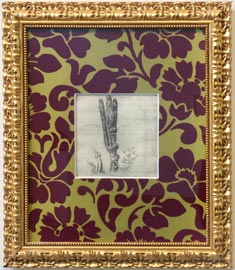
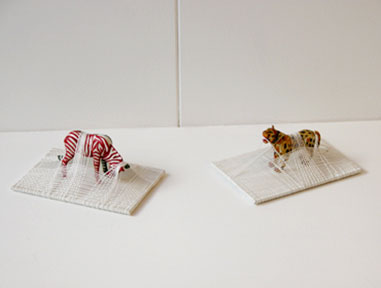
Biography
ANILA RUBIKU (1970, Durres - Albania)
Lives and works between Milan and Tirana, Italy
In 1994 she graduated from the Academy of Fine Arts in Tirana and moved to Italy to study at the Academy of Brera, Milan and graduated in 2000.
In 1998 she attended the Advanced Course in Visual Arts at the Ratti Foundation, Como - with visiting professor Hamish Fulton.
In the last ten years she has lived for long spells in various cities abroad (New York, Los Angeles, London and Prague). In 2000 she won the bursary “Artists in Residence” from the Leube Art Program which took her to Vienna (where she attended master courses by Renée Green and Michelangelo Pistoletto at the Akademie Der Bildenden Kunste) and to Salzburg. In October 2004 “Gallery talk at Apexart Gallery, NY” invited her to speak about her work. In 2005 she won the 2nd Prize in the category "Light Sculptures" of the Targetti Light Art Award 2005 and now her work is part of the Targetti Art Collection and London Deutsche Bank collection. In 2007 she was invited by the Jerusalem Center for the Visual Arts as Artist in Residence. She won the ArtsLink Residency October- November 2008 NY, (USA).
Special Projects
2008 One Night Only the U.S. premiere of the video installation at Taliesin West – Frank Lloyd Wright’s national historic landmark home and studio in Scottsdale – in collaboration with ASU Art Museum, Arizona, U.S.A.
2007 Workshop The Ethiopian Embroiderers in collaboration with Jerusalem Centre for Visual Arts( JCVA), Tel Aviv, Israel. Directed by Nirith Nelson.
2006 "Taipei Contemporary Ink Painting Biennal". Taipei, Taiwan.*
Two weeks workshop Echigo-Tsumari Art Triennial 2006, Japan.*
2005 Yellow Stickers: Urban intervention project in simultaneously with the 51st Venice Biennale, courtesy Gallery The Flat - Massimo Carasi. (Curated by Elisa Marras).
1999 Workshop and Mercedes Benz Prize Centro d’Arte la Loggia, Montefiridolfi, (FI). Italy. (Directed by Amnon Barzel, Fabio Cavalucci and Pier Luigi Tazzi).*
Solo Exhibitions
2010 Laws, Lies, Traditions & Convictions, Josza Gallery, Brussels. Belgium
2009 Imagine the possibilities, Gallery Alessandro Bagnai. Florence, Italy. (Curated by James Putnam)*
2008 Panoramic Landscapes, Herzliya Museum Israel.
The 16 ways, Gallery Braverman By Art Projects. Tel Aviv, Israel.
2006 Something in common Gallery Anita Beckers, Frankfurt, Germany.
Getting lost in Venice it's wonderful Gallery Traghetto. Venice, Italy. (Curated by Aurora Fonda).*
2005 Object of Desire, Gallery The Flat - Massimo Carasi. Milan, Italy. (Curated by Gabi Scardi).
2004 Viaggio/Trip Studioventicinque, Milan, Italy. (Curated by Paolo Campiglio).*
2001 Home sweet home, Gallery “Il Graffio” in Bologna, Italy. (Curated by Michele Robecchi).
Group Exhibitions
2010 Edition 5 Erstfeld at the Haus für Kunst, Altdorf, Switzerland. Säen und Jäten –Volkskultur in der zeitgenössischen Kunst. Städtische Galerie Bietigheim-Bissingen, Germany.
Non totalmente immemori, né completamente nudi, Galleria Communale d’Arte Contemporanea di Monfalcone. Italy. (Curated by Andrea Bruciati, Eva Comuzzi)
2009 Fragile, fields of empathy, Daejeon Museum of Art, Daejeon. South Korea.
Marvellous Reality Lalit Kala Galleries (part of the Lalit Kala Akademi- the National Academy of art) organised by Gallery Espace, New Delhi, India.*
The Symbolic Efficiency of the Frame, 4th Tirana International Contemporary Art Biennial, Tirana, Albania. (Curated by Joa Ljundberg & Edi Muka) *
Säen und Jäten –Volkskultur in der zeitgenössischen Kunst”. Städtische Galerie Ravensburg, Germany. (Curated by Dr. Nicole Fritz)*
Threads, National Queer Arts Festival 2009, at SOMARTS Gallery, San Francisco, California,USA (curated by Pamela Peniston & Courtney Dailey)*
Fragile, fields of empathy, Museum of Sant Etiene. France (Curated by Lorand Hegyi)*.
Windows onto the Sea, Strasbourg. France (Curated by Dimitri Konstantinidis)*
Fuorisalone 2009, Plusdesign Gallery, Milan, Italy.
Dritto Rovescio, Triennale Museum, Milan, Italy
2008 One Night Only the U.S. premiere of the video installation at Taliesin West – Frank Lloyd Wright’s national historic landmark home and studio in Scottsdale – in collaboration with ASU Art Museum, Arizona, U.S.A.
MLB Home Gallery & Rocca Rinascimentale di Cento (Ferrara) ( Curator Marialivia Brunelli).*
Micro narratives, Museum of Sant Etiene. France (Curated by Lorand Hegyi)*.
Mediations Biennale. Un voyage sentimentale 1st Poznan Biennial, Poland .*
The – Bearable Lightness of being- The metaphor of the space, Palazzo Pesaro Papafava., 11th 11th International Architecture Biennale Venice, Italy.*
Emergenze Creative MAR Museo d’Arte della Città di Ravenna, Italy.( Curator Marialivia Brunelli & Silvia Cirelli).*
Fil Rouge MLB Home Gallery & Rocca Rinascimentale di Cento (Ferrara) ( Curator Marialivia Brunelli).*
The thread as the line: Contemporary sewn art, Ellipse Arts Centre, Arlington, Virginia, USA (Curated by Cynthia Connolly).*
Women’s Images/Frauenbilder, Kunsthalle Lingen, Germany.( Curated by Dr. Heiner Schepers).
2007 Ouverture. Privat tales, Hungarian Academy Rome - Palazzo Dei Falconieri, Rome. Italy (Curated by Achille Bonito Oliva & Lorand Hegyi).
48th October Art Salon Belgrade, Serbia. Yugoslavia. (Curated by Lorand Hegyi)*.
Just in Time, Gallery Riccardo Crespi, Milan. Italy. (Curated by Gabi Scardi)*.
2006 L'immagine sottile, Galleria Communale d'Arte Contemporanea di Monfalcone. Monfalcone, Italy. (Curated by Andrea Bruciati).*
Echigo-Tsumari Art Triennial 2006, Japan. *
Das Pferd erzählen, Kunsthalle, Göppingen. Germany. (Curated by Dr. Werner Meyer, Dr. Annett Reckert).*
Travelling Light. Nothing to lose, Chelsea Art Museum, New York, USA (Curated by Julia Draganovic). *
2005 Viaggio leggero, Niente da perdere, Galleria d’Arte della Provincia di Modena, Chiesa di San Paolo, Modena. Italy. (Curated by Julia Draganovic).*
No place like home, Associazione Gaibazzi, Parma, Italy (Curated by di Federica Bianconi).*
Zone di Transito, Gallery A+A, Venice, Italy. (Curated by Aurora Fonda ).*
Detroit International Film and Video Festival, Museum of New Art (MONA) Michigan, USA.
BoundLess, Partecipating/contributing in Jan Christensen installation. Stenersenmuseet, Oslo, Norway. (Curated by Henry Meyric Hughes).
2004 Place for the Self, Apexart, New York ,USA (Curated by Amnon Barzel).*
Colours of Albania, National Gallery, Tirana, Albania. (Curated by Edi Muka).*
Selected Awards
2005 2nd Prize category "Light Sculptures" Targetti Light Art Award 2005. Artefiera 2006, Bologna, Italy.
1999 Mercedes Benz Prize Centro d’Arte la Loggia, Montefiridolfi, (FI). Italy.
Public Collections
Israeli Museum Collection, Jerusalem, IL.
Deutsche Bank Collection, London, UK.
Targetti Art Light Collection, Florence, Italy.
Collection of Galleria Comunale dell'Arte Contemporanea di Monfalcone, Monfalcone, Italy.
Collection of Anthony and Heather Podesta, Washington, DC.
Edition5 Collection, Erstfeld, Switzerland. *
~~~~~~~~~~~~~~~~~~~~~~
Olga Kisseleva
Exhibitions
CHRONOGRAPHY
The project of Olga Kisseleva, Chronography, gathers a set of new works that extend the reflection of the artist over the society and more especially on time. After having explored the ‘biologic time’ and ‘individual time’ with the art piece It’s Time shown at the Louvre Lens and at the iIndustrial Biennale of Contemporary Art at Ekaterinburg, then the ‘economic time’ during her exposition Time is Money, Money is Time at the foundation Sabanci at Istanbul, the artist is gonna dig the time issue by approaching space-time continuum concept.
With her new exposition at Jozsa gallery, she will bring face to face the installations Time-Value and Particules Alimentaires. These two artworks analyses the consequences of the purely economic management of the world and time depending in which country we are.
The pictures of Particules Alimentaires, as flemish still-life coming from the 17th century, are compound by a whole bunch of articles, stolen from a supermarket by a person caught in the act. Each image is accompanied by an analyze of the thief profile written by a sociologist and an art historian.
Time-Value is a calculation considers the lifetime, the numbers of workings hours in a year, the safety index, … That allow a company to optimize the costs through the relocation of its production.
By showing those two installations in a same exposition Olga Kisseleva is pushing us in thinking about the consequences of the choices made by the actors of the society and their priority values. It’s with humor that the artist emphasizes a few incoherences of attitude, time perception, of the world or even ourselves when we are passing through the public area to the private area.
Tulipomania is a piece that sends back to the first economic crisis generated in the 17th century by the speculation. Two different times so two different space-time continiua are meeting in this artwork. This art piece is mixing former art with wall drawings of a tulip and new art with technologies and augmented reality.
The title of the exhibition Chronography finds all its meaning in a new version of the set CrossWorldsprimarily build by the superposition of measuring tools of space and time.
At last, the series Contre Temps, develops from the performance, executed as part of the opening exhibition of the Louvre Lens, appears as a measure of time by space: a dance during 10 hours while a kilometer of red tissue is deployed all around the Louvre museum. This red tissue, thus disposed, creates the symbol of the infinite. This action accents the role of art which enables the ideas and the mind to cross or even to defeat the time and take them to infinity.
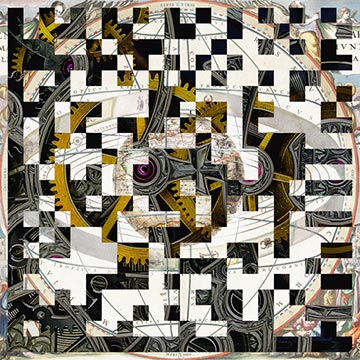
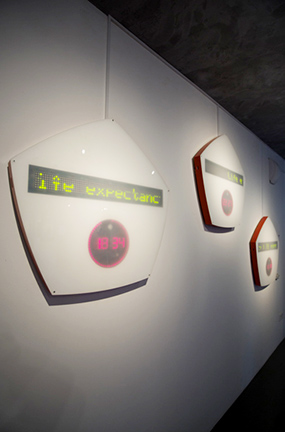
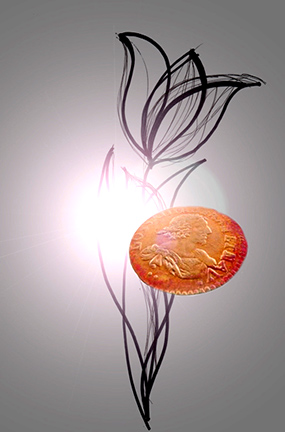
BOÎTE DE VICES
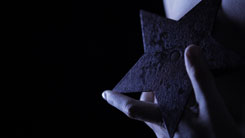
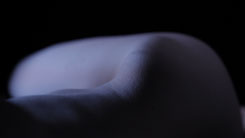
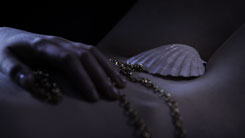
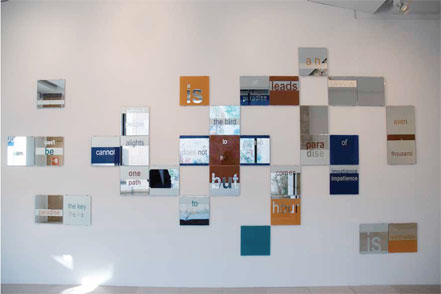
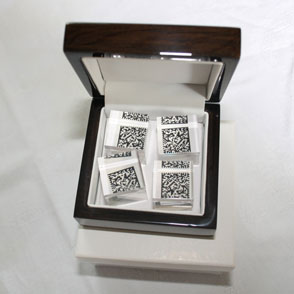

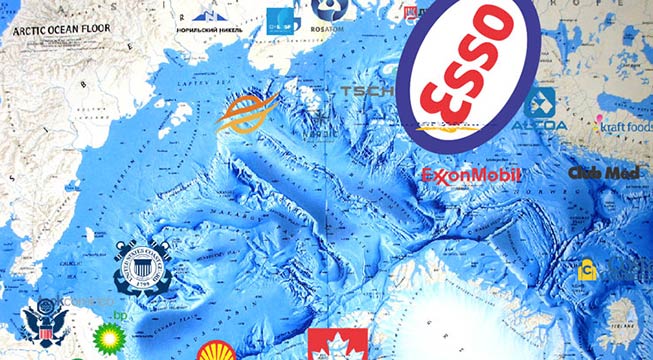
DIVERS FAITS
The project “FAITS DIVERS” turns around a photographic series of contemporary still lifes and consisting of a narrative text for each photograph.
If the historical references of the project and the use of allegorical codes obviously come from the Dutch painting of the 17th century, Olga Kisseleva’s still life pictures can be read in multiple semiotic and emotional layers thanks to all the objects that are part of the compositions.
In the 21st century, like in the 17th, the object can have different levels of meaning: through its form, material, colour and use, but also through its nature, its relation to other objects, persons or places. One can seize and interpret the references immediately.
In addition to this immediate perception, the artist will refer to her illustrious predecessors, adding another layer of meaning, the level of history or tradition, using, for example, the “dictionary of the objects” of the Northern Renaissance, the local and popular customs, the social, professional, geographical and, of course, nutritional references. The wrapping, the colours, and the absence or presence of logos are not used innocently, and so, the composition of those everyday objects will refer the viewer to a message other than just promotion(or commerce): and a story of loves, friendship, conquest or discovery.
During the creative process, the artist relied on a team of art historians, a sociologist and a writer. First they compiled a contemporary dictionary of the system of symbols of food and everyday objects. Then, writer Helena Villovich was commissioned to write 49 short stories. Inspired by the everyday life of the artist, each text is based on some keywords taken from the dictionary. Finally, a still life was composed on the basis of each story. The objects selected for the still life correspond to the keywords at the heart(or root) of the story.
Viewed as a sequence, the photographs present a chronological narrative, a panorama of the everyday, a semiological essay of contemporary food industry.
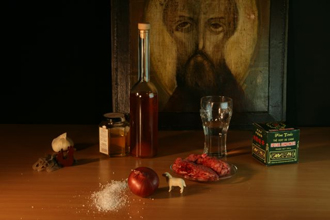
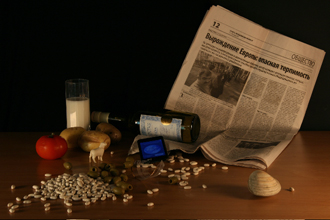
FITNESS ART CENTRE
Graduated from St. Petersburg University, Olga Kisseleva (1965) is one of the most accomplished Russian artists of her generation.
From the beginning of the 90s, on the invitation of the Fulbright Foundation, she found a roof for her work in the research group in the United States which dealt with the development of digital technologies. In 1996 she is getting her PhD for her theoretical work on the theme of new forms of hybridization and she is invited to the Fine Art Institut of 'Hautes Etudes' in Paris. Since then she has been developing original work in which is oscillates between truth and untruth and she is searching for improbable boundaries that separate both. In all of her projects the viewers very much take part, thereby the artists challenges the ability of new media to create a true picture of reality.
For her first personal exhibition, Jozsa Gallery shows a selection of her most recent works - an opportunity to discover the artistic approach of this important Russian post-diaspora artist.
The lighting of 'Conclusive Evidence' shows that the distance between Brussels and St Petersburg is turning to 0.
The digital animation 'Conquistadors' examines the tensions and conflicts that define the Russian territory in the age of privatization. Ironically commenting the 'global conquests' that has become standard practice in the current stage of post-communist capitalism, this work provides a dystopian picture of space completely reappropriated by the capitalist enterprise.
In 'Fitness Art Centre', a screen is linked to a body-building machine that visitors are invited to use. Doing so activates images of demonstrators projected onto the screens but blurred by the random appearance and disappearance of big brand logos. The whole set-up bears witness to world dominated by a state of political confusion and individual manipulation.
'CrossWorlds' helps visitors to translate in real time the subliminal information in textual form. Olga Kisseleva places electronic tags detectable with a simple mobile phone in photographs or in a video-animation. Into the 'CrossWorlds - Dow Jones' the messages encoded are from propaganda both from the American style of life and from Soviet propaganda. According to Susan Buck-Morss' analysis, the similarity between them is evident although they are formulated in different ways.
Works
Born in St Petersburg in Russia, Olga Kisseleva shares her time between her home city and Paris.
Founder of Laboratoire Art&Science; at Université Paris 1 Panthéon-Sorbonne, she plays a central role in pioneering research and reflection on emerging forms of creativity.
Olga Kisseleva’s installations challenge our affinity with the world in an excessive, hyper-connected, hyper-consumer society. Thus she affords visitors the opportunity to pause a while, look at an exhibit, and gain some perspective on their use of digital technology and their attitude to the way they consume.
The digital world, sciences, nanotechnologies, coded messages… all come to almost palpable life in Olga Kisseleva’s artworks. Strange objects and surprising devices give substance to the artist’s installations, only unveiling their mysteries to the enquiring spectator who then penetrates an invisible universe inhabited by numbers, figures and lines of code, where Time passes, purchased at lightening speed like a commodity on the stock market. Or, the spectator uses a smartphone connected to the worldwide web to unlock the secrets of QR Codes—for better or for worse; ultimately, it’s their own rapport to all things digital in their daily, excessive, time-consuming use that is revealed to them in brief sentences or videos.
Olga Kisseleva’s work has been shown in numerous collections and exhibited notably at the MoMA (New York, USA), National Centre for Contemporary Arts (Moscow, Russia), ARC (Paris, France), KIASMA (Helsinki, Finland), Consortium (Dijon, France), Museo Nacional Centro de Arte Reina Sofia (Madrid, Spain) and at the Venice, Istanbul, Dakar, Tirana, Rennes, Moscow and Berlin Biennials.
~~~~~~~~~~~~~~~~~~~~~~
Naturalia / part 2
Group Show May 19 - July 4 2011
NATURALIA / part 2
with Ruth Gómez, Hjort, Anila Rubiku, Ruud Van Moorleghem
Commissariat: Richard Neyroud
Naturalia / part 2 shows four approaches of human nature: from mutation to anthropomorphism, from sex to cannibalism. As there is a science for nature, there is also a science for human made in the 18s century by David Hume in A Treatise of Human Nature. For Hume, morality is a history of perceptions and feelings more than ideas. This confusion leads us to reflect on the nature of these impressions and how they operate on us. Our approval of the present will depend on our feelings. From this arises a distinction between vice and virtue. In this case, any attempt of rationality would be futile. Through narration and animation, human nature is more acceptable beyond the scope of morality. And Naturalia / part 2 is a narrative exhibition in which fantasized or imaged scenes are shown by five artists. Social hierarchies and power relations summon our attention around gallows. Quirks and overflows found in a civilization in search of identity in which the human conquered its place in a nature in watermark.
The characters of Ruth Gómez (Spain, 1976), drawn from the comics, advertising and video clips, present a sadistic humanity. His animated films thus draw a portrait of society: the metaphors at play reveal a malevolent human dimension where the balance of power and the question of survival are omnipresent. Chewing gum under an air of Vivaldi brings human vanity to its climax while a scene of anthropophagy turn to festive.
Hjort (France, 2009) is a collective of two artists, Laurie Enrique & Hélène Letessier, who mix their worlds in the realization of drawings and animations assisted by computer. From screen printing to walldrawing, they disproportionate bodies and their graphic environment until we lose our bearings. The graphic compositions in which mutated animals, humanized monsters, human silhouettes combine and create by their fantasy a new mythology.
The drawings of Anila Rubiku (Albania, 1970) establish relationships between body, sex and environment. Arizona, with its desert landscapes and its sudden urban and demographic growth was the ideal place to develop this series. Sexual scenes, embroidered on paper, arise in a wild and desert environment.
The performance, drawing, installation and sculpture of Ruud Van Moorleghem (Belgium, 1988) derive from his own dreams and ramblings. His follies are macabre; even the festive is disturbing. Love, sex, death, identity are recurring themes in his practice. Between attraction and repulsion, his objects and performances question our relationship to life.
NATURALIA with Magali Lefebvre, Leon Glenda, Jonathan Loppin and Miks Mitrevics
White card for Richard Neyroud
NATURALIA groups together four artists who explores the concept of landscape through different media: photography, installation and video. Naturalia literally means "natural things" and is based on the iconography of cabinets of curiosities. The curiosities shown in the exhibition are to be considered as various potential reconstructions of a mental landscape.
Landscape is not such an unusual theme. It was particularly developed by the artists of the world and by the theme of the subject. Nevertheless, there are aspects to be discoveredthought. The concept of landscape not only evokes nature, but also society because it is precisely the
product of the interaction between Man and his environment.
For the series entitled Chemical Valley, Magali Lefebvre (France, 1980) photographs of the subject: industrial buildings, characterized by the absence of man. The obscurity, the light, and the framing transform these industrial structures into miniature sites. A longer exposure gives the photographs their unnatural light. Between fiction and glimpses of reality, these pictures have a cinematic presence, worthy of the fantastic.
The videos of Glenda Leon (Cuba, 1976) are the expressions of a dream. Cada Respiro sees a flowergrow at each breath of a young woman at rest. Leading the nubes is based on an idea of quantumphysics by which each can, through will power and concentration, change the shape of clouds. In this video, Jonathan Loppin (France, 1977) attempts to decipher the workings of our world through simple contraptions. 4h33 is a sink with a tap, connected to electricity. A never-ending flow of water is created, rendering time meaningless. The piece takes on the appearance of a nightmare: endlessly
flowing water , not drop by drop but like an inexhaustible source. Halo is a device consisting of a gas bottleand a block of cellular energy which is tested for its resistance to heat. The time-based experiences to which the artist confronts us play finely on the lines between dream and reality.
As for the installations of Miks Mitrevics (Latvia, 1980), they turn towards small details, sensory impressions created by places, which elements suddenly attract our attention. They are presented in the form of experimental laboratories. Through these composite installations, the artist's questions and our personal relationship to nature and landscape - playful and poetic landscapes - ceaselessly transformed by Man.
The pieces shown in this exhibition can be considered as poetic notes on the theme of landscape. froma simple image, the artists lead us to rethink our own relationship to our environment. The play on scales - miniaturization, enlargement - conditions
Between industrial aesthetic, poetic expression and ecological positions, NATURALIA is a story of
gardens, a place to reflect and share.
~~~~~~~~~~~~~~~~~~~~~~
Alexia de Ville de Goyet
Exhibitions
HARRI DE VILLE Les Ombres sont déjà des murs
“The poetic image is not subject to a growth. It is not the echo of a past, it is quite the contrary: by the glare of an image, the distant past resonates of echoes and we don’t see up to what deepness those echoes will be reflected and vanish.”
Harri De Ville is a duo project by Sabrina Harri (1979, Finland) and Alexia de Ville de Goyet (1982, Belgium).
First working with video performances, their research have lately evolved through sculpture and installation, defining an interdisciplinary language where abstraction and narrative elements merge.
The starting point of the collaboration was a live performance inspired by the text “Bildeschreibung” of the german writer Heiner Muller. The duo finds inspiration in philosophical literature. The Poetic of Space by the french philosopher Gaston Bachelard is an essential discovery for their future work. This essay treats about how the lived-in and human experience of architecture affects and shapes it’s development (even the development of dreams and memories). Harri de Ville starts using light, sound and video projections in their sculptures.
The central piece of the exhibition “Les Ombres sont deja des Murs” places the viewer at the center of a sculptural environment, escaping from the space of the gallery.
The viewer, dived into the dark, enters a tiny room revealing its deepness through a video projection. He discovers in the video an empty flat where only some furniture has been left behind. He goes deeper into that flat, and passing door after door he distinguishes a window, a wall, a cupboard, a lamp... The darkness takes away the possibility for him to understand the space fully. He looses his marks. Not moving, the viewer turns in circles though. This darkness is as the oblivion, left aside by the memory. The shadows projected onto the walls transforms the space of the gallery into an environment close to the dream and a mental claustrophobia. This piece is participating to the intimacy, the vertigo and the invasion of the space.
The drawings and the scale model sculpture that open the exhibition strength the theme of the experience of the space by their composition, their transparency and the fragility.
The esthetic positioning of Harri de Ville plays with the loss of orientation.
Stiffing, totalitary walls from which resonates further narrative fragments, suggesting an inside life that tends to fade away but never vanishes completely.
HIDE THE CURSE
Alexia de Ville de Goyet (1982) is a young Belgian artist, graduated form the ERG (Brussels). She lives and works in London.
Her practice is articulated mainly through video, but extends itself also to drawing, sculpture, installation and performance.
Her videos dive the viewer into reality and its different representations that influence our relation to the world around us. our everyday life is indeed invaded by a huge amount of information that interferes with our understanding of the world and constantly stimulates our subconscious. The systems of representation insidiously introduce in our life a slide into another dimension, closer to fantasy.
The issue of Identity, the formal research and the experimentation of the narrative codes are essential. Her texts gather most of the time generalities where personal stories and stolen sentences blend together. The loneliness of our modern society is always seen in her work as a fatality. This concern is the fulcrum of her research and lead in one way or another to the disappearance of the body. The characters are staged, outdistanced of their own speeches, passive and active at the same time. Narrative fictional film that imitates the documentary codes and where what is said is never what is given to be seen. We are inside the character’s thoughts, in his story, even if he remains fragile, transparent, almost nonexistent.
“The language is fascinating. We build it with words, no matter if they are placed the one next to the other, separated of not by comas, whether they tell or hide what we think, that we use formulas, proverbs, metaphors, if we misuse the grammar, if we don’t finish our sentences, the intention of construction is still always there.” Hide the Curse, her exhibition at the Jozsa Gallery, concerns the theme of construction/deconstruction.
The exhibition includes 2 videos in which we follow the path of a man on one hand and a woman on the other hand. A physical but also inner journey as the text goes through the memory of the characters. The construction as base and the deconstruction that follows, like an inevitable but natural ending after all.
It is also a running of the speech with Coloma where we struggle to follow the rhythm of the words declaimed in Spanish, the subtitles and the image. All this punctuated by black wholes that give us an impression of rest but also disturb our notion of time in the action.
The second video imitates the codes of documentary films. Michael tells us, without describing it though, the story of a trip that changed his life and conscience. If the text was here again written by the artist, she left a lot of freedom to the actor for him to appropriate it with his own ways and words. The hesitations of the actor, that silence that inevitably appears between his words and the calm of the camera movements tips us up between two realities: is it a true story or is it a fiction? This doubt takes hold of the viewer and makes him interpret the story at different levels of understanding.
“I come here again near the exploration of uncertainty in human experience: love, life, death, guilt,..”
The exhibition also includes drawings that concern the same theme, the construction (of sentences, characters, plots, but also spaces) and portray little heaps of stones or bricks, used as symbols of the words, accumulated here and there, and beyond which we can sometimes glimpse a precious stone or a diamond, in the rough or sharpened, that moves us, hurts us, but that never gets ruined or shattered.
The sculptures also take the shape of light and precious stones despite the emptiness that inhabits it. the diamond, symbol of eternal, here becomes fragile, desecrated by its reproduction in plastic tape or neon lights. By its size or by its accumulation, it is losing its unique value. The shape loses then its identity as precious object.
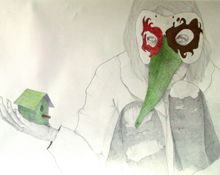
BREAK ME A STORY
Break me a story is an exhibition showing the works of 2 feminine artists :Krista Autio (Finland, 1968) and Alexia de Ville de Goyet (Brussels, 1982). Both are using personal, intimate stories to put the accent on the loneliness in the modern society. For Krista Autio this loneliness is typical of the Finnish society whereas in Alexia de Ville de Goyet’s work it is seen as a fatality. This concern is central in their research and leads for both of them to a disappearance of the body, as in Krista Autio’s serial Les Femmes sont parties.
In her paintings as in the drawings exhibited here, Krista Autio interrogates the society itself. The ludic aspect of her self portraits avoids the moralizing position. After her last solo exhibition at the Jozsa Gallery, Krista decided to leave for a moment the big scale paintings to go back to the simplicity of drawing. The Finnish news led her to do some soul-searching. The Belgian and European medias in general, show Finland as the best educational model but on the other hand we heard about 2 tragic murders perpetrated by Finnish teenagers last year. It is clear for Krista Autio that the Finnish educational system is based on the competition between individuals, and this can only lead to a social dramas (eg : Fast & Happy and Best in Everything). Krista Autio felt like she had to go back to her groundings, using the simplicity and the spontaneity of the drawing (pencil).
In Alexia de Ville de Goyet’s videos, the formal research and the experimentation of the narrative codes are essentials. Natural Histories is a modulable video installation made of 4 short narratives. Those 4 narratives treat about our point of view on the world, our imagination and our dreams as a child or a teenager. They also ask questions of Identity, quest that we face through all the steps of our life. The medium itself is also a central point in Alexia’s work. The characters talk about the act of framing through the photo or the video camera, but also through the process of memory itself. The wonders of her different characters allows her to stage her own contradictions. Her work is partly autobiographical but avoids though the complain of the “I”.
In From the Unknown city, Alexia de Ville de Goyet points out the loss of our identity in the overwhelming of the images. The character would like to erase the past. She wants to have a pure, innocent look on the world around her. This purpose can also be related to the artist in general: what can we do ? Has everything already done ? To protect your mind, your eyes is a fantasy that takes the character into a utopian and contradictory process, active and passive at the same time. The Finnish language uses in the video places de character far away from the viewer, in a kind of no man’s land, whereas her fragility and the fact that she faces the camera makes us feel close to her. The language becomes a music, a tune where the shouts remain shouts but where the text makes us dive into her inner voice.
Works
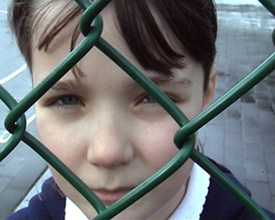
Biography
ALEXIA DE VILLE DE GOYET (1982 Brussels, Belgium)
Lives and works in London
2007-2008 Double Award in Film & Video Production, LCC (London College of Communication), London
2007-2008 Post-Diploma Byam Shaw - Fine Arts, Central Saint Martins, London
2006-2007 Time and Space department - photography and video, Kuvataideakatemia, New Media, Helsinki
2003-2007 ERG (Ecole de Recherche Graphique), Narration - photography and video, Brussels
AWARDS
2007 Astral Chorus, Best narrative film, DIGITmedia festival, New York
SOLO SHOWS
2010
- Hyde the Curse, Jozsa Gallery, Brussels
DUO EXHIBITIONS
2011
- Harri deVille (in duo with Sabrina Harri), The New Gallery, Calgary, Canada
- Les Ombres sont déjà des Murs, Harri deVille (in duo with Sabrina Harri), Jozsa Gallery, Brussels
2010
- Harri deVille (in duo with Sabrina Harri), Sinne Gallery, Helsinki, Finland
- Harri deVille (in duo with Sabrina Harri), Gallery UUsi Kipinä, Lahti, Finland
2009
- White Lies, Harri deVille (in duo with Sabrina Harri), Naisten Huone Gallery, Helsinki
- Spit on Roses, Harri deVille (in duo with Sabrina Harri), Huuto Gallery, Helsinki 2008
- Break Me a Story (in duo with Krista Autio), Jozsa Gallery, Brussels
GROUP EXHIBITIONS
2011
- Wanderers of the Wasteland, Espace FLUX, Liège, Belgium
- Nyt 2011, Together, Raiso Museum Harkko, Turku, Finland
2010
- Flux 10 – New media Festival, WeeGeeMuseum, Espoo, Finland
2009
- BAC!09, CCCB, Barcelona
- Art Fair Finland 09, Cable Factory, Helsinki
- Psyche Target, Turn-Berlin Gallery, Berlin
- Markers 7 - Exhibition, International Artists’ Museum, Venice Biennale
- Crosstalk, Video festival, Gödör Club, Budapest
- Art Brussels, Palais du Heysel, Brussels
- Affluenza Exhibition, St-John St, London
- Squelette, Grütli Theater, Geneva
- S1/Salon, S1, Group show, Artspace, Sheffield, Great-Britain
- Manpower, Cosmic Mega Brain, Lisbon
- MosEspa/Art-en-Ile, live video performance with YERMO, Geneva
- Camus Lit L’Etranger, French Institute, Istanbul
- Terre des Hommes Remix, Pathé Palace, Brussels
- Camus Lit L’Etranger, Salon du Livre, Paris
- Camus Lit L’Etranger, Foire du Livre, Brussels
- Soirée Squelette, live video performance with YERMO, Grütli Theater, Geneva
2008
- Camus Lit l'Etranger, live video performance, Festival Brussels
- Spiritual Promises from Lost Prophets, Beyrouth & London
- Jeune creation, La Villette, Paris
- New Contemporaries, BLOOMBERG, Liverpool & London
- Les Inattendus Festival, Lyon, France
- The Third Bicycle, Lauderdale Gallery, London
- Binocular, Kingsgate Gallery, London
- Portrait n.m., JCG Contemporary, Brussels
2007
- Cartes Flux, Weegee Museum, Espoo, Finland
- The Consequence, Glasgow, UK
- Windows, Le Bonheur, Brussels
- Videologia Festival, Volgograd, Russia
- Optica Festival, Gijon, Spain
- Raw Festival, New York
- Digitmedia Film Festival, Tusten Theater, New York
- Name Festival, VJing performance, Lille, France
- Tehdas, VJing performance, Wegee Exhibition Centre, Espoo, Finland
- Pixelache Festival, Bio Rex & Mbar, Helsinki
- Performance Festival, VJing and sound live performance, Pispala Contemporary Art Centre, Tampere, Finland
- The Night of the Arts, Happihuone central park, Helsinki
2006
- Humans and Animals, City Happenings, Helsinki
- Unknown City, City Happenings, Helsinki
- Nos Restes, La Quarantaine Gallery, Brussels
~~~~~~~~~~~~~~~~~~~~~~
Natalia de Mello
Exhibitions
THE SONG OF THE ORACLE
Art classifies and unclassifies, it creates and disrupts, it arranges and deranges the world in its representations and manifestations. Still, it should not be that it is vain to think, reflect, theorize about or even want to define art. On the contrary, art nurtures itself from these efforts and even though it does not progress. Art will always be naturally ahead of its time. It's always going to be exactly where it's going to come from - and that's exactly what it's all about. Thus we should try to understand the artist and not believe in art.
If art can not bear any definition, it can not be expected to exhaust the complexity of its existence. - provided that any of us has true access to art, intellectually and materially - the possibility of engaging oneself in this world of art to make happen. This way we could even say that we do not want to do anything about that paradox, that Oscar Wilde suggested that we do not want to do that, at least that life proceeds from art.
All the same, if art consists in cultivating singularity, it is no doubt the best way to start a dialogue with the other - and that is different - the same general indifference.
This encounter with the Other through art necessitates a consistent work of mediation upstream. A real art propaedeutic that calls for cultural politics as well as the politics of sensitizing youth to contemporary artistic expression. A way of acknowledging the art produced by our contemporary artists who deserve no statues but at least a statue. A work of "proximity" in the context of indifferent involvement, suspicious or mocking profane in a dialogue with art. To locate the issue of art in the heart of the debate
Daniel Van der Gucht
I also do nice things but do not forget to plug the plug!
Inseparable from encounters, collaborations or chance control themes, the work of Natalia de Mello has been guided since 2000 by the dual concern of the relationship to space and the relationship to the other, the relationship of the work to the public.
Her taste for collaborations and the desire to go beyond the limited boundaries of the visual arts led her to invest in the world of the living arts and to participate or to initiate shows, performances that will become so many places for multimedia experimentation and hybridization of artistic practices and digital technologies.
For her first solo exhibition at the Jozsa gallery, Natalia de Mello offers us what makes the essence of her art through recent and older works from different themes. "I'm doing cool stuff too, but do not forget to plug in!" "Connects some facets of his reflections such as the relationship between science and art, between the human and the machine, between domesticity and domestication.
Inframince projection then! set the tone. Taking up the eponymous aesthetic concept of Marcel Duchamp, the artist reflects on this almost imperceptible and yet essential difference that governs the relationships between people and things. Thus she films in negative the piece in which will be projected the video integrating the reality of the comings and goings of the collaborators who become so many presences and absences. The inaugural projection that covered a metal curtain 20 m long integrated the comings and goings of the public crossing the space like so many black ghosts.
Initiated in 2003 during its participation in the exhibition "The Science of Art" at the Jacques Franck Cultural Center, the AMI project proposed to everyone to create a robot-friend on a human scale, with artificial intelligence but who especially expresses his feelings interacting with his / our environment. A relationship of friendship disempowering since it suffices to press a button to terminate temporarily or permanently this relationship.
The exhibition is punctuated by short video sequences from his project LAGUTROP (correspondences and landscapes from the back). This project is born from a collaboration with the sound artist, Margarida Guia. If the context of political and economic crisis that prevailed in Portugal last summer was the basis for the whole project, it is more poetic moments it distils here and there in the gallery: the game of a slug with a mirror, the pages of a book that turn with the wind, the unlikely discoveries of a watered computer and a dvd-scarecrow in a garden shambles, as many magical moments of a daily life that we do not notice or hardly ... infra-thin too.
Biography
NATALIA DE MELLO (1966 Lisbon, Portugal)
Lives and works in Brussels
Graduate in graphic design and stimulation, ENSAV, La Cambre, Belgium.
Training in videography, photography, engraving.
EXHIBITIONS (selected)
2016
Rereading the world, connecting people, 25 artists for the 25th anniversary of the Stolen Letter, Brussels, Belgium.
2015
Transcultures @ Digital Art Festival Taipei 2015 - (video) Taiwan
EYES CLOSED; Curated by Christophe Veys. A selection of works from Vey's-Verhaevert's collection and Jozsa gallery's artists. Brussels, Belgium.
MY GARDEN IS IN YOUR EYES; Curator: Laurent Busine, Director of the Museum of Contemporary Arts in Grand-Hornu. Wallonia-Brussels Center, Paris, France.
ArtBrussels , Jozsa gallery, Brussels, Belgium.
No place like home, group show, Jozsa gallery, Brussels, Belgium.
Transcultures @ Festival Vidéoformes, CLERMONT-FERRAND France.
CITY LIGHT - FESTIVAL VIA 2015, initiative of the Numediart Institute of U-Mons in collaboration with the Mons 2015 Foundation, Brussels, Belgium.
2014
State of the art, meeting around my work invited by Frédérique Bianchi and Jean-François Pirson, Brussels, Belgium.
MUSIC VIDEO ART, Palace of Fine Arts Lille, France
ArtBrussels , Jozsa gallery, Brussels, Belgium.
Transmutation, group show, Jozsa gallery, Brussels, Belgium.
The black work, group show, Jozsa gallery, Brussels, Belgium.
2013
Me too I do nice stuff but do not forget to plug the plug !, Jozsa gallery, Brussels, Belgium.
Cultivate your strangeness, Maison Folie de Mons, invited artist to stage, stage, and orchestrate the different proposals of young artists from ARTS2, Mons, and cultural associations of Mons. As part of the event "Think the Future", Brussels, Belgium.
2012
LAGUTROP performance, correspondences and landscapes from the back. With Margarida Guia as part of Transnomades # 4 / Transcultures. House of the cultures of Saint-Gilles, Brussels, Belgium.
Composition for 16 computers, Web Workshop, Brussels, Belgium.
Sonic Cinema, Aremberg Art Gallery, Artistic Curator, Anne-Laure Chamboissier and Philippe Franck, as part of the City Sonic Festival. Brussels, Belgium.
Portrait robots, Connectic'arts, production Transcultures, Brussels, Belgium.
2011
Landscapes bureauTIC low-TEC, exhibition + performance evening Free radicals with Gauthier Keyaerts + video retrospective evening, Jacques Franck Cultural Center, Brussels, Belgium.
Anonymously Yours, Maison Grégoire, Brussels, Belgium.
GPS: Gioconda Painting Show, with Valérie Cordy, "A step towards the future", Center Wallonie-Bruxelles, Paris, France.
Here ... See what the sculptures are dreaming of, the ISELP Art Film Festival, Brussels, Belgium.
GPS: Gioconda Painting Show, with Valérie Cordy, Plan K Refinery, Digital Arts Commission of the French Community, Brussels, Belgium.
2010
Frames of explorasons or Magnets are the lovers of nails, Days of the inheritance of Oise / Transcultures, Rivierre nail shop, Creil, France.
Free Radical Performance with Gauthier Keyaerts, Transcultures, FEST 2010, Carthage, Tunisia.
Fragments 37 # 40 + Bye Dad with Gauthier Keyaerts, Brussels Electronic Music Festival, Bozar, Brussels, Belgium.
Free Radical Performance with Gauthier Keyaerts for the inauguration of the theme week "Technology my love", League of Human Rights, Brussels, Belgium.
A design, an option - thirty years of drawing in La Cambre, Brussels, Belgium.
Free Radicals, Videographics 21, Liège, Belgium.
2009
Free Radical Performance with Gauthier Keyaerts, Transcultures, Sonorama Festival, "Soundscape", Besançon, France.
Free Radical Performance with Gauthier Keyaerts, "Background noise: Brussels Sonic", Transcultures, Maison des Métallos, Paris, France.
The sound is expressed, Transcultures, Center Wallonie-Bruxelles, Paris, France.
My little screen, XVIIIth Prize for Engraving and Printed Image, Center of Engraving and Printed Image, La Louvière, Belgium.
2008
Here ... and there, the statues of our city contemplate us, with Evelyn Fischer, bookstore Quartiers Latins, Brussels, Belgium.
2007
Doppelganger3 , "Daily under control", collective MéTAmorphoZ, thematic week of the League of Human Rights, Brussels, Belgium.
AMI is built thanks to you !, "Multiple", The Stolen Letter, Brussels, Belgium.
Hitting ..., streamingfestival 2nd edition, online festival for audio visual art, Holland.
AMI is built thanks to you !, XVIIth Prize of Engraving and Printed Image, Center of Engraving and Printed Image, Louvière, Belgium.
2006
Banging ..., festival 19th digital video and poetic moments, Mar del Plata, Argentina.
2005
AMI is built thanks to you !, festival "Danse en vol", theater of L'l, Recyclart, Brussels, Belgium.
Metamorphoses: technological conference, MéTAmorphoZ collective, VIA festival, Maison Folie, Mons, Belgium.
Survival attempt for 9 or 147 people, Atelier 340 Muzeum, Brussels, Belgium.
2004
J'tapLDkjpe, collective MéTAmorphoZ, theater of the Doms, festival of Avignon, France.
Urban and Artificial Flower Bank, "Between Being and Beech", Médiatine, Brussels, Belgium.
2003
Doppelganger2 , MéTAmorphoZ collective, Mons festival at Carré, Belgium.
Temporary area, collective Mé TamorphoZ , "Au Corn" Festival, Recyclart, Brussels, Belgium.
2002
With the Inner Sea, Scenography and Costumes, Edward Bond's play directed by Valérie Cordy, Théâtre Océan Nord, Brussels + Théâtre de l'Eden, Charleroi, Belgium.
Doppelganger1 : who's who, collective MéTAmorphoZ, European festival Netdays, La Bellone, Brussels, Belgium .
Salvador, scenography and costumes, play by Suzanne Lebeau directed by Valérie Cordy, Jacques Franck Cultural Center, Brussels + festival Mons au carré + festival of Huy, Belgium.
Digest, the Universal Declaration of Human Rights, collective MéTAmorphoZ, "100 Artists, 100 Years of the League of Human Rights", Brussels, Belgium.
AMI, instructions for use, "The science of art", Jacques Franck Cultural Center, Brussels, Belgium.
2001
In the Inner Sea, scenography and costumes, Edward Bond's play directed by Valérie Cordy, Theater Factory, La Bouverie + Les Arbalestriers, Mons, Belgium.
Temporary Zone1, MéTAmorphoZ collective, Netdays multimedia festival, Brussels, Belgium.
2000
Works of art, Artists in window, Brussels, Belgium.
Dry cleaning, "[connective] 2", Les bains :: connective, Brussels, Belgium.
Who we are, Brussels 2000, Brussels, Belgium.
What we are, "Ondertussen-among others, De Markten, Brussels, Belgium.
1999
Uma Visão sobre os anos 80-90, PLMJ collection, Lisbon, Portugal.
1998
Drawings, photographs, individual exhibition, Interior Polygons, Brussels, Belgium.
Prospectives, ARTGO and Christine Debras, Brussels, Belgium.
A century of collage in Belgium, Center for Engraving and Printed Image, La Louvière, Belgium.
1997
Generation 80-90, La Cambre, Brussels, Belgium.
1995
Desenho comtemporaneo, Modulo Gallery, Porto, Portugal.
1992
Art Brussels, Modulo Gallery, Portugal.
Modulo Gallery, Lisbon, Portugal.
1991
Rails in view, Le Botanique, Brussels, Belgium.
Lineart, International Art Fair, Ghent, Galerie Patrick Derom, .Belgique
Galerie Modulo, Lisbon, Portugal.
Galerie Brigitte Geerinckx, Brussels, Belgium.
JM Gallery. Gomes Alves, Guimaraes, Portugal.
Modulo Gallery, Porto.
PUBLICATIONS
1991
80 artistas em Portugal, Margarida Botelho Editores reunidos, Lisbon, p. 242-245. Catalog, Modulo, Lisbon, Portugal.
1992
Catalog, Modulo, Lisbon, Portugal.
1998
A Century of Collages in Belgium, Catalog, Center for Engraving and Printed Image, La Louvière, p.94-96
1999
Uma Visão sobre os anos 80-90, Catalog, PLMJ, Lisbon, Portugal.
2000
Ondertussen-Entr'autres, production of a mini-newspaper, De Markten, Brussels, Belgium.
Cultural Joints, CERA Foundation, Leuven, p. 16-31. Belgium.
The Science of Art, Catalog, Jacques Franck Cultural Center, Brussels, p. 20-21.,
The color of water, 11 watercolors accompanying a text by Anne Penders, Liaisons, n ° 23, p. 16-23
2006
Sea, catalog, Atelier 340 Muzeum, Brussels, p. 338-339
2010
A design, an option, thirty years of drawing at La Cambre - edit ESAPV - La Cambre, Brussels.
2012
Here ... Look, what are the statues dreaming about? with Evelyn Fischer, with the support of the French Community of Belgium Plastic Arts and Service Education Department. Publication of the book and DVD, La Lettre Volée editions. Belgium.
2013
Board Cards - Ask yourself a question deep within yourself and pull a card - editions La Lettre Volée, Belgium.
2015
SUCCE Fluxus - With the support of the French Community of Belgium Plastic Arts and Service Education Department. Publication of the book to the editions of La Lettre Volée. Belgium.
~~~~~~~~~~~~~~~~~~~~~~
